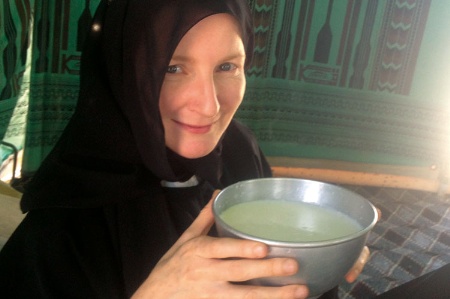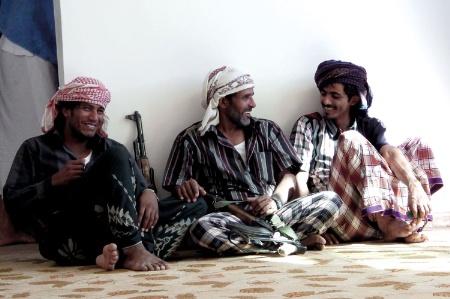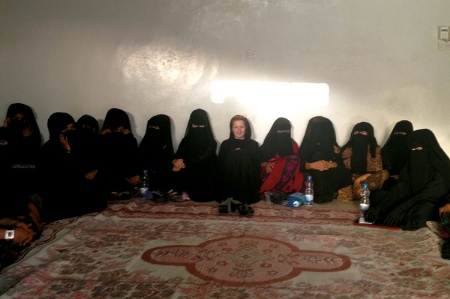Source: Corbis
I wanted to find out whether the decades of training I’d had in literary theory, literary criticism and Arabic language could be brought to bear on something that was a bit more real
“You know how in the Asterix books they form the turtle formation of shields?” asks Elisabeth Kendall, senior research fellow in Arabic and Islamic studies at Pembroke College, Oxford. “It felt a bit like that.”
She is describing the occasion late last year when she was invited to address about 260 people who were being sworn in as delegates to the first cross-tribal council in the Mahra region of eastern Yemen. After some of her minders had gone ahead to carry out initial reconnaissance, she set off across the desert in a convoy, with four cars in front of her and four behind. Once they reached their destination, she says, “the entrance to the election hall was so thick with Mahri tribesmen that you couldn’t get a shot through”.
After the end of her speech, her minders said: “‘Let’s not wait around for the end of the celebrations. Let’s take you out now. We feel a sense of danger.’ They literally marched me out, men to my left and right, one ahead and one behind, straight into the vehicle. As I came down the steps, they had all the tribes lining up. And then there was the Land Cruiser ahead, with all the guys with guns in the back of it.”
Although at the time “it seemed like massive overkill”, Kendall admits that subsequent events led her to think again. “There was a meeting a few days later in the next tribal region, Hadramawt, where they were trying to establish their own representative movement. The guy who organised it was assassinated on the way back from the meeting.”
Little in Kendall’s earlier research career was quite so dramatic. She spent almost a decade from the mid-1990s investigating a school of experimental writing that emerged in Egypt in the late 1960s, in the aftermath of Israel’s victory in the 1967 Six Day War. She collected copies of long-forgotten magazines, interviewed the surviving writers and analysed their work as part of “a literary political movement”, noting how they often portrayed “the depressed isolated individual at the margins of society, revealing the angst of defeat”.
Yet working on such difficult poetry, recalls Kendall, began to feel “a bit like studying in a cocoon. I wanted to understand how cultural and literary products intersect with the world. I wanted to find out whether the decades of training I’d had in literary theory, literary criticism and Arabic language could be brought to bear on something that was a bit more real.”

In parallel with this, Kendall spearheaded a successful bid to establish a language-based area studies centre at the University of Edinburgh, in collaboration with the universities of Durham and Manchester. This became the Centre for the Advanced Study of the Arab World, where she served as director from 2008 to 2010, responsible for “a huge conference on jihad and martyrdom in 2009: we brought together scholars, academics, policymakers, spies and former terrorists to discuss the issues from a variety of perspectives”.
The outbreak of the Arab Spring in 2010, however, spurred Kendall to refocus on her own research rather than directing other people’s. She negotiated a research-based position at Oxford and joined forces with British and Egyptian political scientists to survey public opinion in Egypt in the aftermath of the revolution. By now very interested in jihad, she began to turn her attention to “the increase in jihadist journals being published in Yemen. I thought, I know how to research journals. I can use my expertise to look at the literary content of the journals, which everyone else is ignoring, and the role it plays in what governments call winning hearts and minds, where we are missing a very obvious component. Websites analysing jihadism always skip over the poetry.”
To quote some examples of the poetry she has examined, the verses discussed in a forthcoming book chapter, “Yemen’s al-Qa’ida and Poetry as a Weapon of Jihad”, in Twenty-first Century Jihad: Law, Society and Military Action, include the lines: “Is there any martyr whom we desire to be united with us in love,/and whose dowry is a flowing ocean of blood?”; and “I will fasten my explosive belt,/I will shudder like a lightning bolt”.
It is not prudent to travel to the heartlands of al-Qaeda poetry in central Yemen. (The Foreign Office website advises “against all travel” in Yemen, mentioning terrorism, the risk of kidnap and civil unrest.) Kendall reports that she goes to Sana’a, the country’s capital, to collect what she can: “There’s one bookshop which looks ordinary, but if they know you they’ll take you out to the back and up some stairs and you’re surrounded by all sorts of dodgy material. Last time I spent a full afternoon there and just sat there, like in an Aladdin’s cave, and photographed what I could. But I felt like I was being watched and a couple of bearded guys made me feel very uncomfortable.” Yet she also realised that the Mahra region was “a fairly safe, quiet area – useful as a base to investigate the al-Qaeda poetry in the country’s centre”, and tried to set up a visit.
Kendall was introduced to a man called Salem Bin Abdullah Bin-Ashour Al-Mahri, whose father had brought the different tribal groups together in the 1960s. Although Al-Mahri’s father was assassinated in 1972, Al-Mahri was smuggled out as a baby and still has great credibility with the tribes.

When Kendall first visited Mahra in 2011, therefore, “Salem set it all up – and I now know why. It was always their plan to find someone who would be daft enough to go in and help them,” she jokes.
There is widespread feeling among the Mahri that their concerns were ignored in the National Dialogue Conference, which took place in Yemen from March 2013 to January 2014, and particularly their hostility to plans to amalgamate with Hadramawt in order to create one of six new federal regions. When Kendall first visited in 2011, therefore, “Salem knew I was doing work in Egypt around surveys and there were discussions about how we can get across legitimately the views of the ordinary people of Mahra.”
She drafted a questionnaire and helped organise the first ever survey of the Mahri population, which took place in December 2012. This revealed “the problems, political aspirations and, surprisingly, that the tribes want to bury their blood feuds and unite”. From this came the new, elected cross-tribal council, for which Kendall created “a code of conduct setting out 10 basic points about nepotism and bribery and so on”.
While she continues to study al-Qaeda poetry, she has become increasingly involved in local politics. The initial survey inspired great enthusiasm in Mahra, where she believes people are “sick of groups of sheikhs claiming to talk for them”. But they remained very concerned about the federal plans, “[saying] until they are blue in the face that it’s a ridiculous idea, that there’s a lot of blood between the Hadramawtis and Mahris”. Since another full-scale survey was unrealistic, they carried out a poll, with Kendall having to advise them “to ask a neutral question, because they were suggesting questions such as ‘Do you want the blood of your grandchildren to be on your hands by joining with the enemy?’” In the event, they managed to secure just over 35,000 responses.
Armed with far more information about their views, Kendall now “flies into Sana’a for meetings with embassies and the UN to try to get justice for these tribes”. She describes herself as an international adviser “trying to bring attention to a problem brewing there, with a war over resources, stockpiling of weapons, smuggling of drugs, guns and people. The chronic underdevelopment and lack of opportunity brings instability, so that as al-Qaeda is pushed East [within Yemen] it’s potentially going to find a willing home.”
In the course of such work, since Elisabeth is not an Islamic name, Kendall has come to be known as “Doctoora Aisha”. Yet her research remains highly dangerous. She tends to enter Mahra from Oman, so at the desert border “20 or so cars are waiting for me and my escort…We pick up guns at the closest petrol station. It’s a bit like picking up a hire car. Everyone has his particular gun. We normally try and drive through the night to the capital Al Ghaydah, where all the representatives of the tribes have gathered to meet us – and everyone is up all night talking.

“The first times we were sleeping pretty rough. Now a concrete compound has just been finished, though still with no furniture, and I have the room in it where I can close the door. The guys are on the roof listening for drones, with others outside the window.”
It is also near the border that Kendall stops to put on her black polyester abaya, which she describes as “very square and frumpy” (as well as hot). On her first few visits, most of the men refused to shake her hand. This has slowly changed and she has now “started unveiling my face when we are sharing trays of lamb or camel. And I’ll roll up my sleeves to eat with the men. They all roll up their sleeves and I didn’t want my big black thing dangling in the rice. It’s a big deal to eat with the men, but they invited me. Now I’ve started taking the face veil off, because it’s much easier to communicate, especially when we are all speaking in a second language.”
Another happy development was when a woman suggested she should “wear the traditional Mahri dress. It’s cotton, much more flowing, purple and colourful, with a big scarf over the head – it’s miles cooler. And when I first came out in it, everybody was so happy and said ‘She’s become a Mahri!’ though I also got a lot of ‘I need a fourth wife’. It was good-natured, but it was as if I’d stopped being some academic honorary man and had suddenly become a woman.”
Although Kendall is delighted to be able to abandon her black abaya, she does remember an occasion when wearing one taught her an important political lesson.
She was flying out to Yemen just after a massive suicide bombing at a military parade, so a number of FBI agents and American military were on the same plane. After changing into her abaya in the lavatory, she found herself at visa control as part of “a sea of black women. Then these big American guys walked straight to the front of the queue and slapped down their passports right in front of me like I didn’t exist. So I picked them up and screamed: ‘What the fuck do you think you’re doing? Get to the back of the queue!’ They were so shocked! They act like they own the place. No wonder they are hated.”
Register to continue
Why register?
- Registration is free and only takes a moment
- Once registered, you can read 3 articles a month
- Sign up for our newsletter
Subscribe
Or subscribe for unlimited access to:
- Unlimited access to news, views, insights & reviews
- Digital editions
- Digital access to THE’s university and college rankings analysis
Already registered or a current subscriber?





